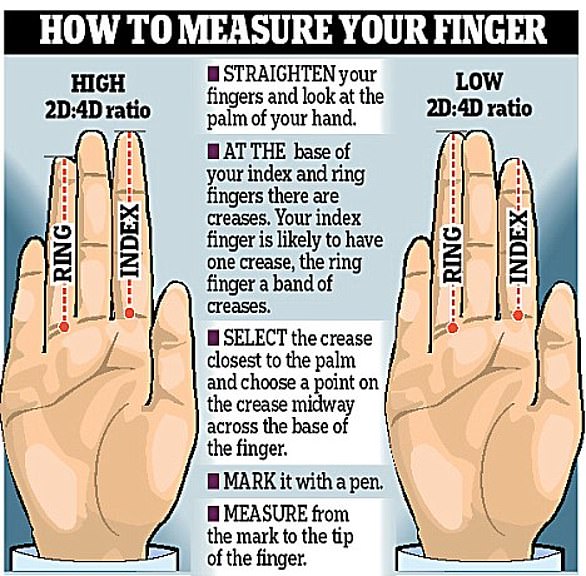Ordering yet another beer from the bar often feels like a impulsive, spur-of-the-moment decision.
But a surprising new study suggests many of us are predisposed to boozing well before birth.
Scientists at Swansea University quizzed more than 250 people on their drinking habits while measuring the length of their fingers.
Finger length is thought to be a metric for how much testosterone we were exposed to in the womb – and therefore how ‘masculine’ we are.
According to the findings, the more testosterone we’re exposed to in the womb, the more alcohol we drink as an adult – although it’s unclear why.
‘Alcohol consumption is a major social and economic problem,’ said study author John Manning, professor of evolutionary biology at Swansea University.
‘Therefore, it is important to understand why alcohol use shows considerable differences across individuals.
‘It is possible that differences in alcohol consumption are set in the womb.’


Professor Manning is best known for his work on 2D:4D digit ratios – the difference in length between the index and ring finger.
He thinks having a longer ring finger than index finger means you were more exposed to testosterone (the male sex hormone) in the womb.
Meanwhile, having a longer index finger than ring finger means you were more exposed to oestrogen (the female sex hormone) in the womb.
Both boys and girls are exposed to testosterone in the womb and all humans have different levels of male and female sex hormones.
‘Digit ratio (2D:4D) denotes the relative length of the second and fourth digits,’ Professor Manning said.
‘This ratio is considered to be a biomarker of the balance between fetal testosterone and oestrogen.’
For this new study, Professor Manning and colleagues measured the ring and index fingers of 258 adult students – 89 men and 169 women.
Participants were also quizzed about their drinking habits, which were recorded as grams of alcohol consumed per week.

Overall, people with higher alcohol consumption had a ‘low digit ratio’ (meaning their ring finger is longer than their index finger) and hence had higher testosterone exposure in the womb.
This link between alcohol consumption and low digit ratio was strongest for men with long ring fingers on the right hand.
While the exact reason for the link is unclear, Professor Manning thinks having more testosterone in us increases alcohol tolerance, perhaps by making our blood absorb less of it.
‘Enzymes in male stomachs can reduce the absorption of alcohol by 30 per cent whereas females absorb more into the bloodstream,’ he told The Sun.
The findings, published in the American Journal of Human Biology, suggests our alcohol consumption habits are ‘dependent on prenatal sex-steroids’, the team say.
However, more research would be needed to explore ‘causal relationships’ – whether they can prove testosterone exposure in the womb is causing us to drink more alcohol when we’re adults.
The team admit the study used only students, which may represent a very particular subsample of the population as far as drinking habits are concerned.
However, the students – recruited from the Medical University of Lodz in Poland – were ‘not alcohol dependent’.

There have already been plenty of studies linking 2D:4D digit ratios with particular physical and social trends, including income, athletic potential, anxiety and diet.
A University of Vienna study from 2021 found women who have a ring finger longer than their index finger (suggestive of prenatal testosterone exposure) have better hand strength.
Researchers in Scandinavia also found hungry people with longer ring fingers than index fingers order more typically ‘masculine’ food – such as steak rather than salad.
Previously, Swansea University researchers found children born to a mother with an above-average income had longer ring fingers.
‘Mothers with high income may secrete high levels of testosterone relative to oestrogen early in pregnancy, thereby masculinizing their male and female children,’ Professor Manning said at the time.
‘In contrast, women with low income may secrete low levels of testosterone, which will feminize their male and female children.’

